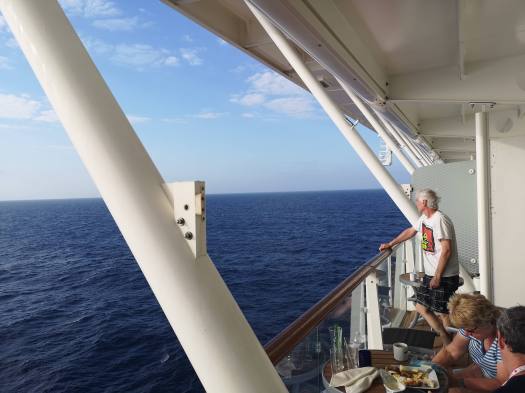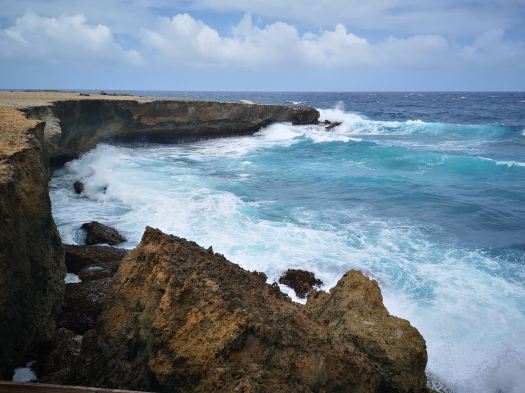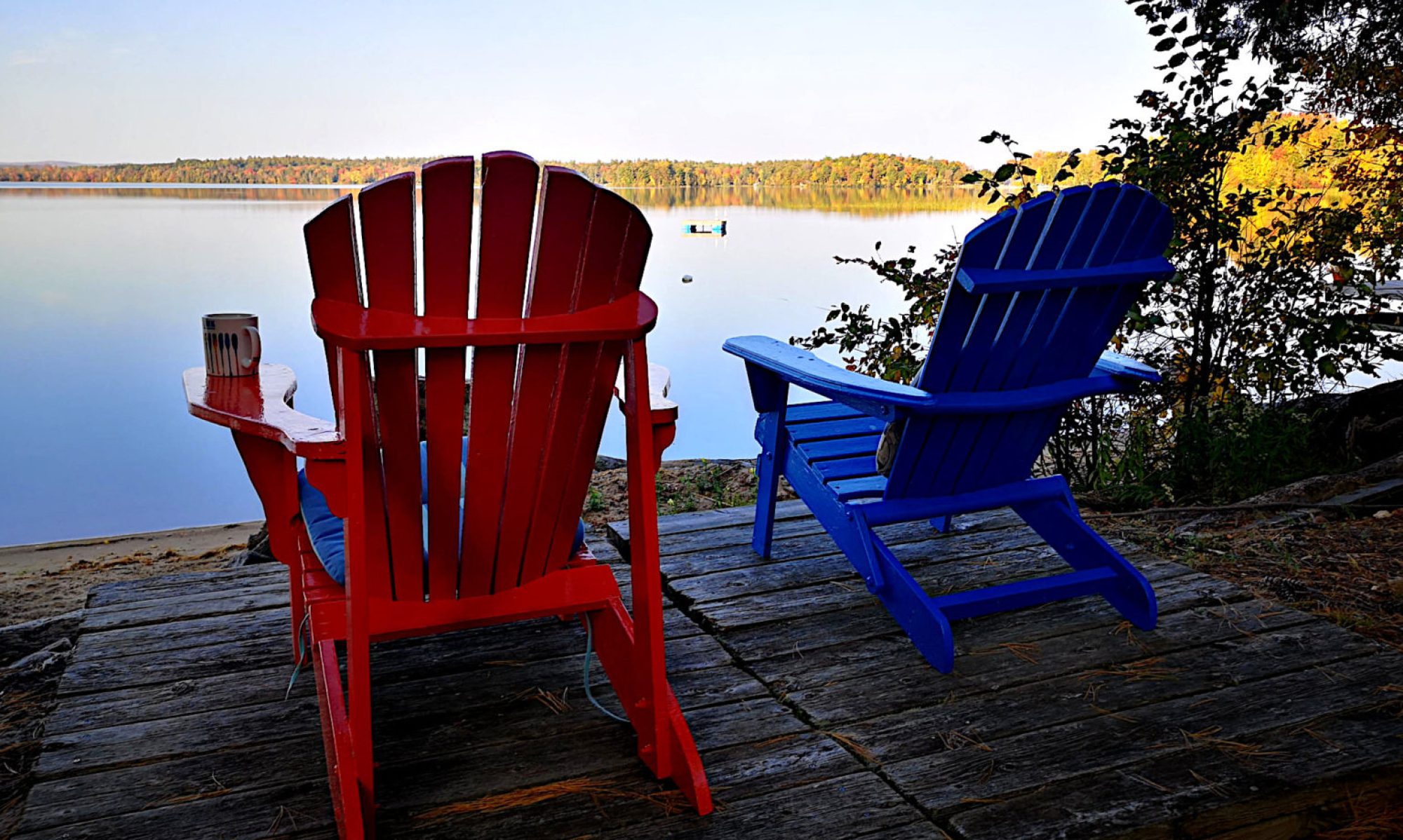Last year, Becky and I and a group of friends rented a fantastic villa on the Amalfi Coast (which you can read about here) and this year our big group trip was a cruise — eleven of us on the Celebrity Silhouette, which sailed out of Fort Lauderdale to Grand Cayman, and then to the so-called “Dutch Antilles” islands of Aruba, Curaçao and Bonaire. So I thought I would write up a post about it, partly (as usual) so that I can remember what happened when I look back on it in the future 🙂 I’ve included some photos here, but if you want to see all of them, as well as a few short videos, you can check out this Google Photo album I created for the trip.
A group of us spent a couple of days in Fort Lauderdale before we sailed (others came in closer to sailing) and it was fun to walk along the strip near where we stayed, which was a low-rise hotel complex called North Beach Village. It turns out this complex is part of a group of about 12 properties — including hotels, restaurants and shops — that a Swedish couple own in North Beach, about a block west of the beach itself. I only know that because we talked to the proprietor of the nearby food truck, Lenita (also Swedish). If you happen to be in that part of Fort Lauderdale, I would highly recommend the food truck, which is called The Plaza Bistro. We were there on Wednesday, which is live jazz night, featuring a very talented saxophone player.

I had to work, but a group rented what are called Scoot Coupes to see a bit more of Fort Lauderdale — three-wheeled buggies with open tops and a top speed of about 35 kph. I got to spend a little time in one, which was fun, but if you ever do this I will note that they have a much larger turning radius than you might expect given how small they are. Let’s just say some scratches were left (but the damage was fairly minimal and the owner was very understanding). As usual, I blame my brother-in-law Dave. On a whim, I also downloaded the Bird and Lime scooter apps and rented a Bird scooter briefly, which was quite fun once I figured out how to get the damn thing going — you scan the bar code with the app and then off you go, and when you are done you just leave it on the sidewalk (San Francisco is littered with them, which has become a problem).

Anyway, Friday February 22 was sailing day and we boarded the ship and hung out near the pool until our rooms were ready, and then job number one was getting our room attendant Ronaldo to remove the barriers between our five rooms, which we managed to get all in a row on the port side of the 10th deck (our friend Sandra, who was travelling solo, was by herself in an interior room). Unfortunately, we didn’t realize that the large poles supporting the pool deck intruded somewhat on our balconies, so there was a bit of an obstruction between two of the rooms, but we soldiered on regardless and people just hopped over the pole when they had to. It was great to have a virtually private deck all to ourselves for breakfast and coffee in the morning and late-night get-togethers.
First stop was Grand Cayman, where we booked a tour (not through the ship) that took us out to Stingray City, a sandbar about half an hour away from the island where boats congregate and you can see (and feed) relatively docile stingrays. It was a fantastic day weather-wise, and the rays were very friendly, and then after seeing them we moved a little distance away and snorkeled along a coral reef, where we saw some great schools of wildly coloured fish (none of which I managed to get a photo of unfortunately). We moved a second location and did some more snorkeling, and saw a stingray that apparently likes to be by itself and never comes to Stingray City. She — the large rays are all female, and the males are about half the size — was hiding in the sand, no doubt hoping very much to be left alone, so that’s what we did.

The rest of the tour involved a bus trip with our friend Tim, a Rastafarian originally from Queens, who took us to Hell — a small tourist trap that consists mostly of a T-shirt and gift shop and a post office where you can send a postcard from Hell — and then to the Turtle Centre, where we saw pools and tanks with giant turtles in them. As with most of these kinds of things, including Marineland and even Stingray City, it’s hard to feel totally comfortable watching wild animals move around a small, penned-in area, but the turtle centre is also a sanctuary that has bred turtles in captivity and released tens of thousands of them back into the wild, so that made us feel a little better. Then it was a quick lunch on the beach of fish and chicken from a local restaurant (I enjoyed feeding the chickens on the beach pieces of their relatives, because I am perverse that way), and then it was back to the “tender” and back on the ship.
We spent the next day at sea, which some spent playing bingo or going to various events on the ship, and I spent reading my Kindle and mostly sitting on our balcony watching the ocean go by, which I have to say is one of the things I like most about a cruise. An unexpected highlight was the flying fish (which we first saw during an even on the helipad on deck 3) which I wrote more about here. The following day we woke up in Aruba, where we had arranged to rent several UTVs — all-terrain vehicles — so that we could explore the island. We got three with two seats and one with six, and off we went, armed with a map that the owner had kindly annotated with all the different landmarks and places we could stop or visit. Luckily, our friend Brenda had brought kerchiefs or “buffs” (as they call them on Survivor), because I was unaware of how much of a desert most of Aruba is, and therefore very dusty when you are driving at high speed in an open-air vehicle.

We made our way up the west side of the island, all the way to the lighthouse at the northern tip, and then from there on a sand-dune road along the eastern coast, which consisted of vast stretches of majestic rock that had been carved away by the crashing surf, and not a whole lot else. We stopped to pile some rocks (as one does) and then we stopped for lunch near an old gold mine, which was apparently built to resemble a castle so as not to give away its true purpose to pirates and thieves. Nearby, luckily, was a food truck that served delicious chicken alfredo subs (I was skeptical, but they were excellent) and then a short distance down the beach we found a spot where you could climb down a wooden ladder and into a small cave that had been formed by the water, where there was a natural pool you could swim in — as long as you avoided the current that really wanted to slam you into the coral, that is. I made the trip, but was the only one to swim, and then it was back on the road.

Part of the purpose of getting the UTVs was to drive into Arikok National Park, so we could visit another natural pool deep in the heart of its rocky terrain, but when we got to the park (after visiting a local giant-rock garden called the Ayo Rocks) we found out that the pool was not open for swimming because the surf was too high. Then we toured a small cave with ancient paintings and symbols drawn by the Arawak people who are native to the area, as well as some from missionaries in the 1800s. From there we headed down to the southern tip of the island and past the giant windmills they have there to Baby Beach, a well-known coral inlet with a fantastic beach. After a swim to get all the sand of our trip off, we headed back up to return the UTVs near the port, where a member of the group who shall remain nameless (not me!) had a small altercation with a car while filling the UTVs with gas. Luckily it was nothing major, and both the driver of the car and the owner of the UTV rental place were extremely understanding and there was no charge (thank you Luis of Road Runner ATVs). After a quick photo by the giant Aruba sign and dinner at a local restaurant right by the port, it was back on board.

The following day we woke up in Curaçao, which is the next closest island (it would have been much nicer if they had put them in alphabetical order, but I don’t make the rules unfortunately). It is much larger and more developed than Aruba, with a capital city — Willemstad — of about 150,000 people, and the same brightly-coloured buildings you will find in both Aruba and Bonaire, which give them a very Dutch flavour. Here a few of us rented a car and drove around to swim with turtles etc., and another group including Becky and I went on a catamaran snorkel-and-sailing tour up the coast with our hilarious captain Fritz, a former seaman in the Dutch navy. It was a fantastic day for snorkeling and sailing, and we saw some amazing fish and coral beneath a pier and nearby — unfortunately, a very large oil-and-gas drilling ship happened to be anchored at the pier, which changed the bucolic nature of the trip somewhat, but it was still a great tour. We had an excellent lunch on board, got roasted in the sun, saw some more flying fish and then it was back to town, where we found a great bar right next to the famous floating bridge in Willemstad. Unlike most bridges that move to let ships pass, this one moves horizontally on floats, like a door, and it happened to open and close while we were sitting there, which was great.
The next day it was Bonaire, the smallest and least-developed of the three islands. We got up ridiculously early, in part because it was a short day and we wanted to make the most of it. We had rented scooters, so we met the scooter company lady in a van and we went to pick them up (I almost crashed one into the side of the parking lot while we were test-driving them, but let’s not talk about that right now), and then it was off on a tour of Bonaire. We stopped at a few of the snorkeling and diving beaches that are all up the western coast, including one near the tiny slave huts (barely bigger than a large tent) that housed the slaves who used to mine the salt. We snorkeled and saw some fantastic fish who didn’t seem interested in our presence at all, and drove by the massive piles of salt from the nearby salt ponds, which are owned by Cargill. We saw a couple of flamingos, and mile after mile of barren rock beaches with crashing surf, and then made our way to a lagoon that is famous for windsurfing, where we ate at a local surf shack called Jibe City and watched people race their surfboards.
From there it was off through the heart of Bonaire to the opposite coast, where we found what is known as Thousand-Step Beach, even though the main staircase only has about 230 steps to it (I guess calling it 230-Step Beach just doesn’t have the same ring to it). We hauled our swim fins and snorkels down to the beach, which was composed almost entirely of “finger” coral, which tinkles musically when you walk on it, and saw some great fish and even a turtle. And then it was back on the scooters — which were tremendous fun, if a little nerve-wracking for some of us novices as we had to negotiate traffic circles in heavy traffic. And then back to the port and onto the ship.

What followed was two at-sea days, which were very relaxing after a go-go series of three days filled with excursions. I played a lot of ping-pong (or table tennis, as my Kiwi opponent Steve prefers to call it) and read my books on the balcony and watched the flying fish — and even saw a couple of dolphins leaping through the waves created by our passing. When we got back to Fort Lauderdale, we had a couple of days at North Beach Village again, which was somewhat different than our first visit because we arrived back during March Break, and the hotel was filled with twenty-somethings and a seemingly never-ending supply of beer. They were actually pretty well-behaved for the most part, even if they did occasionally commandeer the pool. We spent some time on the beach, and some of the group visited a local park on rented bikes (I had to work) and Becky and I and Sandra also toured Bonnet House — the former home of Frederic Bartlett, whose third wife gave the property and its 35 acres to the state conservation authority, which turned it into a museum. Bartlett designed the house plantation-style, and then he and his wives (mostly the third one, Evelyn) filled it with a mind-boggling collection of fascinating and in some cases bizarre art and collectibles.

And that’s about it — kind of a whirlwind tour in a lot of ways, with three islands in the space of three days, but with some quiet and relaxing at-sea time at the beginning and the end, and some time in Fort Lauderdale as well as a kind of buffer. All in all, a great vacation with a great group of friends. If you weren’t on this trip and are not related to me and you somehow made it through this entire thing, congratulations! You are one of a select few.
